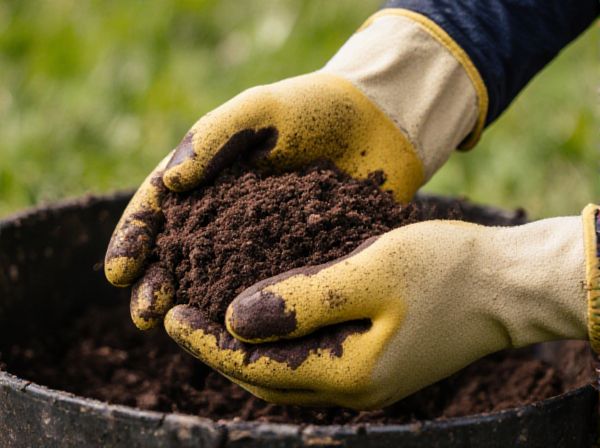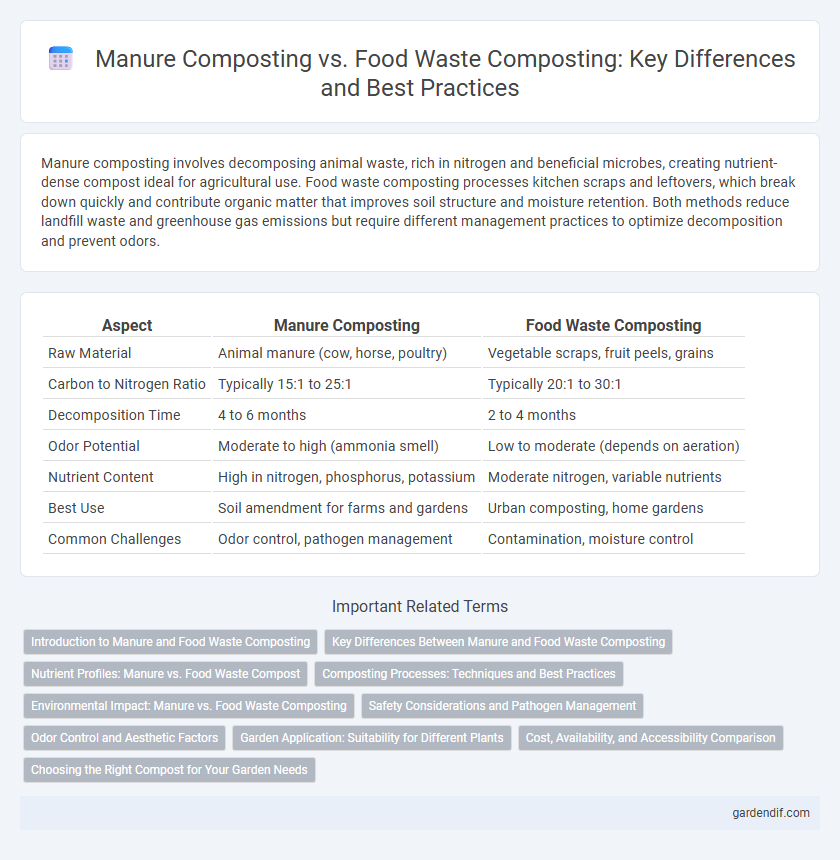
Manure Composting vs Food Waste Composting Illustration
Manure composting involves decomposing animal waste, rich in nitrogen and beneficial microbes, creating nutrient-dense compost ideal for agricultural use. Food waste composting processes kitchen scraps and leftovers, which break down quickly and contribute organic matter that improves soil structure and moisture retention. Both methods reduce landfill waste and greenhouse gas emissions but require different management practices to optimize decomposition and prevent odors.
Table of Comparison
| Aspect | Manure Composting | Food Waste Composting |
|---|---|---|
| Raw Material | Animal manure (cow, horse, poultry) | Vegetable scraps, fruit peels, grains |
| Carbon to Nitrogen Ratio | Typically 15:1 to 25:1 | Typically 20:1 to 30:1 |
| Decomposition Time | 4 to 6 months | 2 to 4 months |
| Odor Potential | Moderate to high (ammonia smell) | Low to moderate (depends on aeration) |
| Nutrient Content | High in nitrogen, phosphorus, potassium | Moderate nitrogen, variable nutrients |
| Best Use | Soil amendment for farms and gardens | Urban composting, home gardens |
| Common Challenges | Odor control, pathogen management | Contamination, moisture control |
Introduction to Manure and Food Waste Composting
Manure composting involves the decomposition of animal feces and bedding materials, offering rich nutrients like nitrogen and phosphorus that enhance soil fertility. Food waste composting utilizes organic kitchen scraps such as vegetable peels, fruit residues, and expired food, providing a diverse carbon-to-nitrogen ratio essential for balanced microbial activity. Both processes reduce landfill waste and produce nutrient-dense compost suitable for agricultural and gardening applications.
Key Differences Between Manure and Food Waste Composting
Manure composting involves managing high nitrogen content and pathogens, requiring longer curing times to ensure microbial safety, whereas food waste composting typically contains more moisture and diverse organic materials, necessitating careful balance to avoid odor and pest issues. Temperature regulation is crucial in manure composting to eliminate harmful bacteria, while food waste composting relies on efficient aeration to accelerate decomposition and reduce methane emissions. Both methods benefit from carbon-to-nitrogen ratio adjustments but differ significantly in their feedstock characteristics and management practices for effective nutrient recycling.
Nutrient Profiles: Manure vs. Food Waste Compost
Manure composting typically yields a nutrient-rich compost with higher levels of nitrogen, phosphorus, and potassium, essential for promoting vigorous plant growth. Food waste compost tends to have a more balanced nutrient profile but may contain higher moisture and lower nitrogen content, requiring careful management to optimize decomposition. Combining both manure and food waste in composting can enhance nutrient diversity and improve soil amendment quality.
Composting Processes: Techniques and Best Practices
Manure composting typically involves aerobic windrow or static pile methods, promoting thermophilic microbial activity to break down high-nitrogen materials safely. Food waste composting often uses in-vessel or aerated static pile systems to manage moisture and odor control efficiently while accelerating organic matter decomposition. Both processes require careful monitoring of temperature, oxygen levels, and carbon-to-nitrogen ratios to optimize microbial performance and produce nutrient-rich, stable compost.
Environmental Impact: Manure vs. Food Waste Composting
Manure composting releases higher levels of methane and nitrous oxide, potent greenhouse gases that contribute significantly to climate change, whereas food waste composting primarily emits carbon dioxide, which has a lower global warming potential. Proper management of manure compost can reduce ammonia emissions and nutrient runoff that cause water pollution and eutrophication in aquatic ecosystems. Food waste composting helps divert organic materials from landfills, reducing methane emissions from anaerobic decomposition while enriching soil health through nutrient recycling and improved microbial activity.
Safety Considerations and Pathogen Management
Manure composting requires stringent pathogen management due to high levels of harmful bacteria such as E. coli and Salmonella, necessitating prolonged thermophilic stages to ensure safety. Food waste composting, while posing lower pathogen risks, demands careful monitoring to prevent contamination from residual packaging and potential chemical toxins. Both methods benefit from maintaining adequate moisture, aeration, and temperature control to optimize decomposition and minimize health hazards.
Odor Control and Aesthetic Factors
Manure composting typically produces stronger odors due to high nitrogen content and requires careful management like frequent turning and carbon material additions for effective odor control. Food waste composting, when balanced with browns and proper aeration, tends to emit milder smells and presents a more visually appealing, less bulky compost pile. Both methods benefit from aeration practices to reduce anaerobic conditions and enhance aesthetic qualities.
Garden Application: Suitability for Different Plants
Manure composting enriches soil with high nitrogen content and essential micronutrients, ideal for nutrient-demanding plants like tomatoes and leafy greens. Food waste composting offers a balanced nutrient profile with organic matter that improves soil texture, making it suitable for a wide variety of garden plants, including flowers and herbs. Selecting the right compost type enhances plant growth by matching nutrient availability to specific garden crop requirements.
Cost, Availability, and Accessibility Comparison
Manure composting generally involves lower initial costs due to on-site availability of animal waste, making it accessible primarily to farms or rural areas with livestock. Food waste composting often incurs higher costs linked to collection, sorting, and transportation but benefits from widespread accessibility in urban settings with established municipal programs. Both methods provide nutrient-rich compost, yet the choice depends on proximity to raw materials and infrastructure investment.
Choosing the Right Compost for Your Garden Needs
Manure composting enhances soil fertility with rich nitrogen and organic matter, ideal for nutrient-demanding plants and improving soil structure. Food waste composting offers a balanced mix of carbon and nitrogen, promoting microbial activity and providing a diverse nutrient profile suitable for general garden use. Selecting the right compost depends on your garden's specific nutrient requirements and desired soil health outcomes.
Manure Composting vs Food Waste Composting Infographic

 gardendif.com
gardendif.com